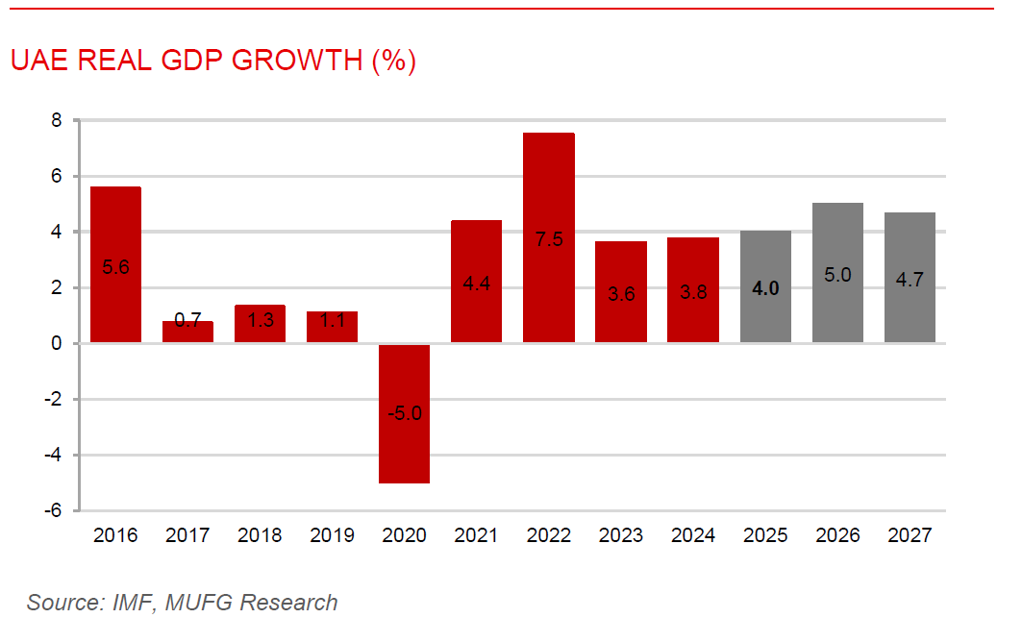To read the full report, please download the PDF above.
Middle East Daily
SOOJIN KIM
Research Analyst
DIFC Branch – Dubai
T: +44(4)387 5031
E: soojin.kim@ae.mufg.jp
MUFG Bank, Ltd. and MUFG Securities plc
A member of MUFG, a global financial group
Middle East Daily
COMMODITIES / ENERGY
Oil steadies as Saudi price cuts and OPEC+ supply additions raise oversupply concerns. Oil prices held steady, with Brent near USD66/b and WTI above USD62/b, as investors weighed demand risks after Saudi Aramco cut prices for most of its crude grades to Asia, including a deeper than expected reduction for Arab Light. The move, coming alongside OPEC+’s decision to add 137,000b/d in October, was viewed by traders as a bearish signal, reinforcing concerns of oversupply into late 2025 and 2026. While OPEC+ has slowed the pace of production hikes compared with earlier months, its focus on reclaiming market share continues to pressure sentiment. Brent remains down about 11% YTD, with recent support from Chinese stockpiling unlikely to offset the looming surplus, raising the risk of further downward pressures on prices.
Gold hits fresh record on Fed cut bets and haven demand. Gold surged to a new record above USD3,647/oz today, extending a rally fuelled by growing expectations of multiple US Federal Reserve rate cuts this year after weak payrolls data boosted bets on easing, including a likely 25bps cut next week. The metal has already gained nearly 40% in 2025, supported by strong central bank purchases, safe-haven demand amid geopolitical and trade tensions, and heightened concerns over President Trump’s attacks on Fed independence. Investors are now watching upcoming US jobs revisions, inflation data, and Treasury auctions to gauge whether the rally can sustain momentum. ETFs have seen their biggest inflows in three months, signalling renewed appetite, though overall holdings remain below peaks reached during past crises, leaving further upside potential if monetary easing and risk aversion persist.
MIDDLE EAST - CREDIT TRADING
End of day comment – 8 September 2025. Strong day overall. For one flows were skewed to buyers, especially ETF accounts provided a constant stream of demand. Then there is still the outperformance of higher beta credits. Today it looked like some shorts were covered in OMAN causing the curve to trade 0.125pt/0.625pt higher and 2/7bp tighter. The only sign of 'weakness' is the steepening of credit curves as long end performance was capped by the flattening of the UST curve and dealer inventory in long end bonds. Take ADGB which has offers in 54s closing +0.625pt/+2bp or QATAR 50s closing +0.5pt/+2bp. In quasi sovereigns it was mixed, outperformers were MUBAUH and QPETRO, the former has a granular curve but strong bids in both the belly (33s +0.375pt/-4bp) and long end, 50s closing +0.75pt/-1bp. In case of QPETRO, 41s saw most activity closing +0.75pt/-4bp. Fin bonds saw demand in 5y Qatari bank names despite Doha Bank announcing a new long 5y bond with pricing/timing still tbd. The new issue window for GCC names remains wide open, but so far only the Saudi complex has used it, that has led to a squeeze in 5-10y curves in ADGB/ QATAR and OMAN. The market is in need of supply there.
MIDDLE EAST - MACRO / MARKETS
Turkey cuts growth forecast to prioritise inflation control and fiscal stability. Turkey has trimmed its GDP growth forecasts under its newly released Medium-Term Program, signalling that policymakers are prioritising price stability and fiscal discipline over rapid expansion. The government now expects the economy to grow 3.3% in 2025 and 3.8% in 2026, down from earlier projections of 4.0% and 4.5%, even as per-capita income is set to exceed USD17,000 with national income topping USD1.5 trillion by end-2025. The cautious stance reflects efforts to tame inflation, which is projected at 28.5% this year. Vice President Yilmaz emphasised gradual structural reforms to lift growth potential without reigniting price pressures, while Finance Minister Simsek introduced new taxes to offset spending tied to the USD90bn reconstruction drive following the 2023 earthquakes. The budget deficit forecast was raised to 3.6% of GDP, underscoring fiscal strain, but the strategy highlights a deliberate shift toward restoring macroeconomic stability, even at the cost of slower growth.
UAE Q1 2025 GDP growth driven by non-oil sectors. The UAE’s economy grew 3.9% y/y in Q1 2025, reaching about AED455bn (USD124bn), with expansion powered largely by the non-oil sector. Non-oil GDP rose 5.3% to AED352bn, lifting its share of the economy to a record 77.3%, underscoring the country’s diversification drive. Key growth drivers included manufacturing, construction, real estate, with trade, finance, and manufacturing together accounting for over 40% of non-oil GDP growth. The results highlight the UAE’s ability to sustain momentum through broad-reinforcing its role as one of the Gulf’s most diversified economies. Going forward, the IMF expects the UAE’s GDP to expand by around 4.0%, while the Central Bank projects growth closet to 4.7%, supported by robust tourism, retail, and credit growth, alongside a steady rebound in oil output.

